Module 6—Work and Energy
 Explore
Explore
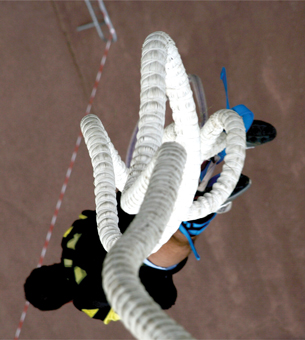
© Stefan Ataman/shutterstock
Bungee jumping is a mechanical system, which is defined by having both potential energy and kinetic energy. Potential energy is the energy of an object that is related to its position—it is also referred to as stored energy. Kinetic energy is the energy of an object related to its motion. The sum of the potential energy and the kinetic energy in a system (such as a bungee cord and jumper) is known as mechanical energy. In order to understand this, you must first understand that energy is not created or destroyed, it is only transferred.
mechanical system: a system that has both potential and kinetic energy
kinetic energy: energy that a body has because of its motion
Work
Technically, bungee jumping starts from the ground. The jumper either climbs a hill to access a bridge deck or is raised up on a platform using a crane. This process involves work that is done against the force of gravity on the surface of Earth. The concept of work must be carefully defined and understood—it has different meanings for different applications. In physics, work is described as the product of force and displacement—vector quantities that have direction.
It is important to note the language that is used in physics to describe work. In physics, we talk about the amount of work that is done “on” an object. For example, if you were to stand still and hold up a 40.0-kg object, you would be using energy; therefore, you would assume that you are doing work on the object. However, this work is not done on the object. Work is done on your muscles as you force them to contract, so no work is actually done on the object, and it does not gain or lose any energy as a result.
If the object does not move through some displacement, there is no work done. In a similar way, if there is no force acting on the object, there is no work done on the object.
Recall from Science 10 that in order to do work on an object, there must be an applied force (which could be applied to overcome a force, such as gravity or friction). The object must also move in the same direction as the applied force (or a component of the applied force).
Work is a measure of the amount of energy transferred when a force acts over a given displacement. It is the product of the magnitude of the applied force and the magnitude of the displacement of the object in the direction of that force. Expressed as an equation, it is
![]()
This is often written as ![]()
| Quantity | Symbol | SI Unit |
| work | W | joule (J or N•m) |
| force (the component of the force that is parallel to the displacement of the object) | F|| | newton (N) |
| magnitude of displacement | d | metre (m) |
1 J is equal to 1 N•m. Work is the product of the magnitudes of two vector quantities. Hence, it is a scalar quantity.
Component analysis is used to find the work done when the force is not in the same direction as the displacement. In such cases, the component of the force that is parallel to the displacement must be calculated before you can determine the work done.
In this diagram, the angle between the Fapp (applied force) and Δd (the direction of displacement) is θ; so, F|| (the force parallel to direction of displacement, which in this diagram is the horizontal force Fh) is calculated as (Fapp · cos θ). Substituting into the original equation, you get the following:
work = (Fapp · cos θ) Δd
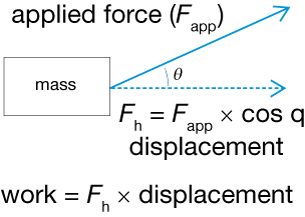
 Read
Read
Read pages 292 to 294 in your textbook to see examples of how this is applied. In “Example 6.1” on page 294, a horizontal force is pushing an object up a ramp.
The following example shows another situation where work is calculated, but this time the displacement is horizontal and the force is applied at an angle.
Example Problem 1
A 25.0-kg box is pulled 12.0 m along a level surface by a rope. If the rope exerts a force of 100 N at an angle of 45.0° to the horizontal, how much work is done on the box?
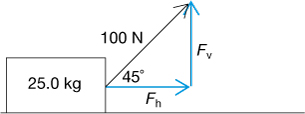
Given
F = 100 N m = 25.0 kg Δd = 12.0 m θ = 45.0°
Required
the work done on the box (W)
Analysis and Solution
The component of the applied force parallel to the displacement will have to be calculated using the cosine function, and used in the work formula.
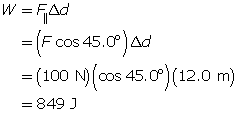
Paraphrase
There were 849 J of work done on the box.
In the next example, the force must be calculated using concepts and formulas learned in previous modules in order to find the work done.
Example Problem 2
A 500-kg motorcycle is travelling at 36.0 km/h and is brought to a stop after skidding 50.5 m. What work did the frictional force do?
Given
m = 500 kg vi =36.0 km/h vf = 0.00 km/h Δd = 50.5 m
Required
the work done by friction to stop the motorcycle (W)
Analysis and Solution
The force of friction and the displacement are parallel, so no angle is required. Force is not given, so it must be calculated using a kinematic formula and Newton’s second law. The first step is to convert the initial speed to m/s.
![]()
Use a kinematic formula to find the magnitude of the acceleration.
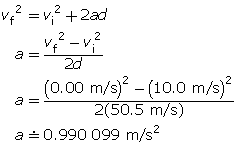
Use Newton’s second law to find the magnitude of the net force.

Calculate the work.
W = FΔd
W =(495 N)(50.5 m)
W = 2.50 × 104 J
Paraphrase
The frictional force did 2.50 × 104 J of work.